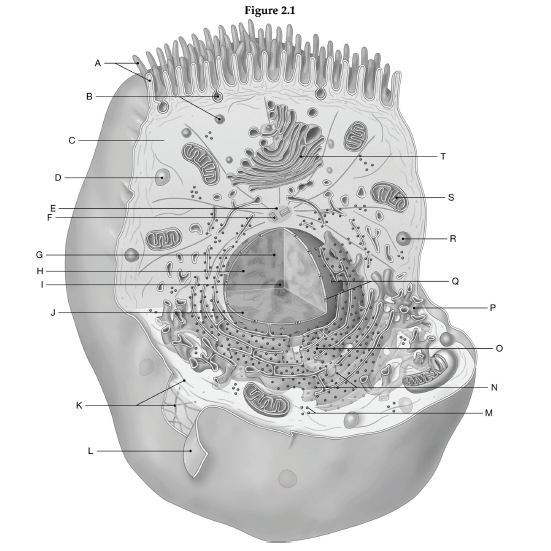Using the figure below, identify the labeled part.

1 Label A: ______________________________
2 Label B: ______________________________
3 Label C: ______________________________
4 Label D: ______________________________
5 Label E: ______________________________
6 Label F: ______________________________
7 Label G: ______________________________
8 Label H: ______________________________
9 Label I: ______________________________
10 Label J: ______________________________
11 Label K: ______________________________
12 Label L: ______________________________
13 Label M: ______________________________
14 Label N: ______________________________
15 Label O: ______________________________
16 Label P: ______________________________
17 Label Q: ______________________________
18 Label R: ______________________________
19 Label S: ______________________________
20 Label T: ______________________________
1 Microvilli
2 Secretory vesicles
3 Cytosol
4 Lysosome
5 Centrosome
6 Centriole
7 Chromatin
8 Nucleoplasm
9 Nucleolus
10 Nuclear envelope surrounding nucleus
11 Cytoskeleton
12 Plasmalemma
13 Free ribosomes
14 Fixed ribosomes
15 Rough endoplasmic reticulum
16 Smooth endoplasmic reticulum
17 Nuclear pores
18 Peroxisome
19 Mitochondrion
20 Golgi apparatus
You might also like to view...
FAD and NAD are coenzymes that act as ________ in biochemical reactions.
hydrogen carriers oxygen carriers energy carriers vitamin carriers
Most muscle work is accomplished by ________
A) treppe B) complete tetanus C) wave summation D) incomplete tetanus
The erectile tissue found in the vaginal wall near opening is called the:
a. clitoris b. vestibular bulb c. corpus spongiosum d. labia minora
The membranes of the blood-brain barrier need to be fused, preventing any substances from entering and/or escaping between cells. The type of intercellular junction best suited for this need is a ________.
A. gap junction B. desmosome C. tight junction D. ion channel